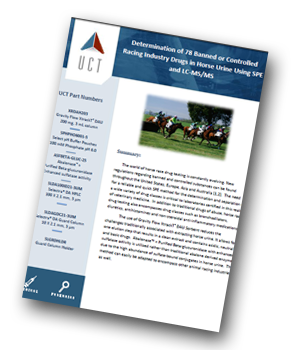UCT has produced an application note for the determination of 78 banned or controlled racing industry drugs in horse urine using SPE and LC-MS/MS.
 Introduction
Introduction
The world of horse race drug testing is constantly evolving. New regulations regarding banned and controlled substances can be found throughout the United States, Europe, Asia and Australia. The need for a reliable and quick SPE method for the determination and separation of a wide variety of drug classes is critical to laboratories certified in this realm of veterinary medicine. In addition to traditional drugs of abuse, horse race drug testing also encompasses drug classes such as bronchodilators, diuretics, antihistamines and non-steroidal anti-inflammatory medications.
Method
The use of Gravity Flow XtrackT® DAU Sorbent reduces the challenges traditionally associated with extracting horse urine. It allows for one elution step that results in a clean extract and contains acidic, neutral and basic drugs. Abalonase™ + Purified Beta-glucuronidase with enhanced sulfatase activity is utilized rather than traditional abalone derived enzyme due to the high abundance of sulfate-bound conjugates in horse urine. This method can easily be adapted to encompass other animal racing industries as well.
Results and Discussion
The application note provides sample pretreatment and SPE procedures, LC-MS/MS parameters and detailed results to highlight UCT's effective solution for determining 78 banned or controlled racing industry drugs in horse urine using SPE and LC-MS/MS.
